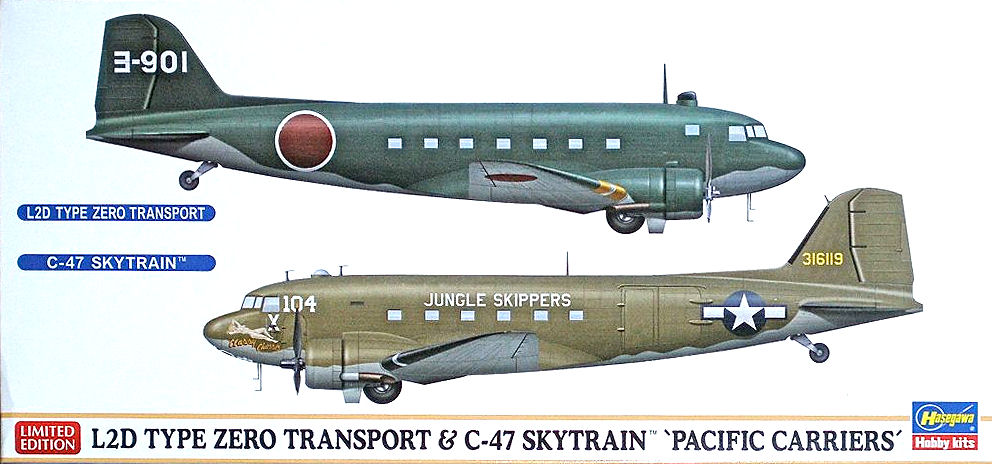L2D Type Zero Transport & C-47 Skytrain
This Special Edition dual kit is a re-release of Hasegawa’s DC-3/C-47 kit with decals included to build two variants of the L2D “Tabby,” the Japanese copy of the C-47, and one USAAF C-47. The parts are typical Hasegawa – molded in gray and with super detail. On my sample, something apparently happened to the C-47 during packaging because it had what looked like tank tracks across the left vertical fin, and the antenna and pitot masts were bent horizontal. It all turned out OK with some putty and re-scribing. The kit could use the addition of some details – there are no exhaust stacks, for instance.
The L2D kit has the World’s Smallest Resin Part included for the antenna cover atop the forward fuselage – and that pretty well typifies the main issue I had with these kits: size. The builds are straightforward, but some of the smaller parts are so tiny, it’s difficult to hold them and clean up sprue nubs, sand off mold seams, and so forth.
The fit of all the parts is terrific. The only place which needed some extra attention with putty and a sanding stick was the lower forward seam where the wing center section meets the fuselage.
The two L2D options are an L2D1 from the Kanoya Naval Flying Group and an L2D2 from the Yokosuka Naval Flying Group. I thought the L2D1 had the more interesting markings, so planned on building that one. In researching the airplane, I discovered the Tabby was powered by Kinsei radials and had decidedly different cowlings which were more tapered, much like the J2M3 Raiden (Jack). I contemplated how to sand the kit cowlings down enough to make them look right, and then discovered through some further Internet research that the IJN had only two L2D1 airframes – and they were built from spare parts furnished by Douglas. The Kinsei powerplants weren’t used until the L2D2 and subsequent variants were manufactured.
That happy news in hand, I went ahead and built the L2D1 with no modifications. (Dodged a bullet there.) If you do want to build a later model L2D from this kit, a little research is needed for the variant you choose, because they started sprouting other changes to the basic C-47 airframe besides engines and cowlings, including a suite of additional windows in the forward fuselage, starting at the cockpit.
I questioned the antenna arrangement on both kits, but it appears there were as many different configurations of those as there were C-47s, so I went ahead and built mine according to the instructions, except for mounting the ram’s horn antenna on the shorter forward fuselage post instead of the tall one aft of the astrodome.
I used Tamiya acrylics to paint both models, then applied the decals. They worked well, and my main complaint was with the powder-blue cabin windows, which I puzzled over, since the Hasegawa C-47 I’ve got in my stash has black ones. I went ahead and applied them, though, and boy, did they stand out. Both models looked like they were using blue CFL bulbs in the cabin and, to my eye, appeared toylike, so I applied black decal rectangles over the blue ones. That sounds easy, but trying to cut all those little things and make them the same size was a job. Happily, the outcome does look better to me.
The second thing which I question about the decals is the inclusion of overwing exits along with the window sets. I think this was a feature added for airline operation in the 60’s. Two colors of decals for the C-47 “Classy Chassis” of the 317th Troop Carrier Squadron are given, with yellow numbers and lettering on one and white on the other. Builder’s choice here, and I opted for white.
The props are delicate, so Hasegawa has cast them in a protective circle of sprue to avoid damage in transit. I was careful cleaning up the sprue nubs on them, and felt lucky not to have bent or broken a blade. I usually paint the warning color on prop tips, but I was afraid the stickum on the tape might bend or break one of these kits’ fragile blades when I removed it, so I used the kit-supplied decal prop tip markings.
The clear parts fit into the flight deck openings after a little sanding of their edges. The astrodome for the C-47 is about the size of Barbie’s contact lens – and just as hard to hold to sand off the sprue nubs. The resin antenna cover for the L2D is marginally easier to hang onto and work with.
When they’re finished up with some subtle weathering and a flat finish, these little models look pretty nice. With the sudden surge in 1/200 scale military kits on the market, these will fit right in with my collection – when I get around to building them, that is.
I recommend this kit to modelers of any skill level who have the eyesight and manual dexterity to work with tiny little parts. That was my main complaint.
Grateful appreciation to Hasegawa, to Hobbico, and to IPMS/USA for allowing me to review this offering. Er, these offerings.










Comments
Add new comment
This site is protected by reCAPTCHA and the Google Privacy Policy and Terms of Service apply.
Similar Reviews